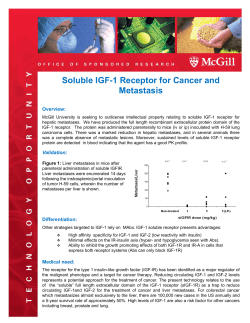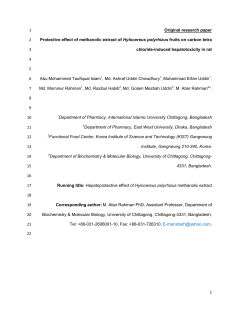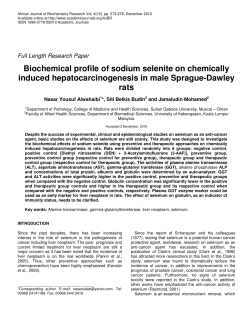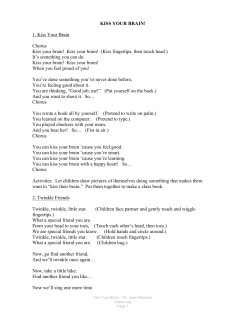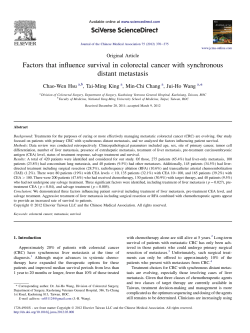
Expression of matrilin-2 during liver regeneration in an experimental
Expression of matrilin-2 during liver regeneration in an experimental model and in hepatocellular carcinoma Ph.D. Thesis Synopsis Erzsébet Szabó Semmelweis University, School of Doctoral Studies of Pathology Supervisor: Dr Zsuzsa Schaff, Professor of Pathology Critical Examiners: Dr Miklós Mózes, Assistant Professor, PhD Dr József Tóvári, Scientific Fellow, PhD President of the Defence Board: Dr András Jeney, Professor of Pathology Members of the University Examination Committee: Dr Ilona Kovalszky, Professor of Pathology Dr Károly Simon, Head Physician Budapest 2007 1. INTRODUCTION Hepatocellular carcinoma (HCC) is one of the most malignant tumors and its incidence has increased in the Western world over the past ten years. In last decades, the cancer research increased our knowledge about the molecular mechanisms and genetic alterations related to liver cancers. However, the exact mechanism and factors implicated in the development of HCC is still not exactly known. The malignant transformation of hepatocytes is a longterm multistep process, which may occur in the context of chronic liver injury, regeneration and cirrhosis. However, the most important risk factors for liver cancer are chronic viral hepatitis B and C. Recently, several studies raised the potential involvement of progenitor cells in liver carcinogenesis and the possibility that HCC could derive from the proliferation of putative liver stem cells. However, the evidence of this hypothesis is to be investigated both in regarding to cell-cell and cell-matrix interactions. Several studies have indicated that certain components of the extracellular matrix (ECM) play prominent role in the neovascularization of tumors during neoangiogenesis. Among these molecules are e.g. collagens, laminin, proteoglycans and other components of basement membranes (BM). Matrix biology recently discovered a new family of oligomeric non-collagenous ECM proteins – the matrilins. The matrilin family has four members. Matrilin-1 and matrilin3 are expressed mainly in the cartilage and bone, while matrilin-2 and - 4 occur in a wide variety of extracellular matrices and BM structures. These proteins have a possible “adapter” function in the ECM, however their exact role in BM structures is not investigated. Recent data indicated that matrilin-2 is an inherent component of dense and loose connective tissue, bone, cartilage, nervous system and in a variety of organs. The potential role of matrilins in tumor development and progression has not been widely investigated. Matrilin-2 was shown to appear in the early stage of cell differentiation and regeneration. However, there are only few studies regarding the expression and significance of matrilin-2 in human tissues and tumors. On the basis of this knowledge the possible involvement of matrilin-2 in cirrhosis, HCC and liver regeneration has been raised. 2 2. The aim of the study 1. To investigate the RNA and protein expression of matrilin-2 in normal rat liver amd normal human liver 2. To examine the expression level of matrilin-2 mRNA and protein during liver regeneration 3. To establish the role of matrilin-2 in liver regeneration 4. To determine the cells involved in the synthesis of matrilin-2 during liver regeneration 5. To examine the differences in the expression of matrilin-2 in cirrhotic liver compared with normal liver 6. To study the differences in the expression of matrilin-2 in hepatocellular carcinomas compared to normal liver tissues 7. To investigate the differences of matrilin-2 expression between carcinomas with and without cirrhosis. 8. To examine how the differentiation grade of tumors contributes to the expression of matrilin-2 protein 3 3. MATERIALS AND METHODS 3.1. Animal models 3.1.1. Partial hepatectomy (PH) Male F-344 rats (180-200g) were used for all experiments and were kept under standard conditions. The animal study protocols were conducted according to the National Institutes of Health guidelines for animal care. Traditional two-thirds PH was performed according to the described protocol by Higgins and animals were sacrificed 24, 48 and 72 hours after PH (1st Institute of Pathology and Experimental Cancer Research, Semmelweis University). 3.1.2. AAF/PH experimental protocol Acetylaminofluorene (AAF) 2 mg/ml suspended in 1% dimethylcellulose in a dose of 5 mg/kg body weight was given daily to the rats on 6 consecutive days by gavage. PH was performed on the seventh day, followed by six additional treatments with AAF. Animals were sacrificed at several time-points (9, 11, 13 days after PH) to determine the particular points of time when the maximum proliferation of oval cells was detected. Untreated animals were used as controls. 3.2. Human tissue specimens A total of 35 surgically resected HCC and 35 corresponding surrounding liver tissues were used for the study. Samples were partly fixed in buffered formalin and snap frozen in liquid nitrogen or fixed in RNA later (Sigma, Saint Louis, Missouri, USA) and stored at -80˚C until further analysis. For RNA isolation RNA later fixed material was used. The material was collected with the permission of the Regional Ethical Committee of the Semmelweis University (#172/2003, # 2/2004). Ten normal human liver samples were obtained from patients who died in accidents or from non liver related diseases. The HCC cases included 19 well, 9 moderately and 7 poorly differentiated tumors according to Edmonson-Steiner’s classification corresponding to grade 1- 3 (G1- G3). The male/female ratio was 27/8, the median age was 64.8 (44-82). In 15/35 cases HCC developed on the basis of cirrhosis and 7/15 cases were HCV infected. The other cases showed no or moderate fibrosis which were scored. In 23 cases (13 HCCs with 4 surrounding liver, 10 normal livers) the size of the specimen allowed detailed sampling for molecular biological analysis. 3.3. Morphological analysis 3.3.1.Histology For histopathology the tissue blocks were fixed in 10% formalin buffered in PBS (pH 7.4) for 24 hours at room temperature, dehydrated in a series of ethanol and xylene and embedded in paraffin. The 3-5 µm thick sections were deparaffinized through graded xylene and ethanol series and routinely stained with hematoxylin and eosin. Then PAS, Shikata-orcein and Picrosirius-red stainings were carried out. 3.3.2. Immunohistochemistry The immunohisctochemical reactions were carried out on paraffin embedded and frozen sections. For the detection of antigens the following antibodies were used: PRIMARY ANTIBODIES • Anti-matrilin-2 polyclonal rabbit serum (gift from dr Ferenc Deák’s group, Szeged, SZBK, Piecha et al., 1999) • anti-laminin monoclonal mouse antibody (Novocastra, Newcastle, UK) • anti-laminin polyclonal rabbit antibody (DAKO, Denmark) • anti -OV-6 monoclonal mouse antibody (R&D, Minneapolis, USA) • anti-CD34 monoclonal mouse antobody (clone QBEnd/10, DAKO, Denmark) SECONDARY ANTIBODY • biotinylated anti-rabbit IgG (ABC kit, Novocastra, Newcastle, UK) • biotinylated anti-mouse IgG (ABC kit, Novocastra, Newcastle, UK) • Alexa Fluor-488- anti - mouse IgG (Molecular Probes, Oregon, USA) • Alexa fluor-568- anti - rabbit IgG (Molecular Probes, Oregon, USA) For the detection of matrilin-2 the signal amplification was enhanced by biotinylatedtyramine according to the protocol. For all sections 3-amino-9-ethyl-carbazole or diamino-benzidine (DAB) was used as chromogens and Mayer’s hematoxylin as nuclear counterstain. Negative controls for nonspecific binding, incubated with secondary antibodies only, were processed and revealed no signal. 5 The immunohistochemical reactions detecting matrilin-2 were photodocumented using light microscopy (200X magnification, Olympus BX microscope, Tokyo, Japan). The immunfluorescence reactions were examined by confocal laser-scanning microscopy (Bio-Rad MRC-1024 system, Bio-Rad, Richmond, CA, USA). Digital images showing immunoreactivity of matrilin-2 were quantified using Leica QWin software (Leica Microsystems Imaging Solutions Ltd., Cambridge, UK). 3.3.3. Statisical analysis The statistical analysis was carried out by GraphPad Prism software version 2.01 (GraphPad Software, Inc. San Diego, CA, USA). The Mann-Whitney U test was used to compare the expression of matrilin-2 in the different groups, p value < 0.05 was accepted as being significant. 3.4. Molecular biological methods 3.4.1.Analysis of mRNA expression a) Microdissection, RNA isolation from rat liver samples Ten µm thin frozen sections from AAF/PH treated and control rat liver were fixed in acetone, dried at room temperature and stained with RNase–free hematoxylin. Laser microdissection was performed using a PALM MicroBeam system (at the 2nd Department of Internal Medicine of the Semmelweis University). RNA was isolated using the RNeasy Mini Kit (Qiagen). b) RNS isolation from RNA later fixed human liver samples by Trizol method Thirteen HCCs with their surrounding liver parenchymas and 10 normal livers were analyzed. RNA was extracted from 20 mg liver samples fixed in RNA later (Sigma) with TRIZOL (Invitrogen, Carlsbad, CA, USA) according to the manufacturer’s instructions. .The RNA pellet was washed once in 70% ethanol, dried and resuspended in 50 µl of RNase free water and kept at -80˚ C until further use. The integrity of total RNA was verified by gel electrophoresis. 6 c) Real-time RT-PCR An aliquot of total RNA was reverse transcribed with M-MuLV reverse transcriptase by using random hexamers. Real-time RT-PCR was performed by using matrilin-2 and GAPDH mRNA specific primers. Specific real time PCR reactions to detect matrilin-2 and GAPDH were carried out with 2µl cDNA template in a total volume of 25 µl, containing 12,5 µl of 1x Sybr Green PCR Master Mix (BIO-RAD 1708882) and 500 nM of each primers, using the ABI Prism 7000 sequence detection system (Applied Biosystems). After initial denaturation at 95 °C for 2 min, 40 cycles were performed at 95° C for 20 seconds, at 63 °C for 30 seconds and at 72° C for 30 seconds. Evaluation of the data for relative quantification to reveal statistical differences between the groups to be compared was calculated with Relative Expression Software Tool (REST) by Pairwise Fixed Reallocation Randomisation Test. Relative quantification method was utilized for data analysis by using GAPDH as reference gene. d) In situ hybridization of rat liver sections after AAF/PH Six µm thin paraffin-embedded sections from AAF/PH treated rat liver were deparaffinized, rehydrated, and washed in PBS. A 644 bp long rat matrilin-2 fragment was amplified by RT-PCR using mouse primers (5’ cctaccccaacggcataca 3’), (5’ tgtgtgaacagtggcgaatc 3’), cloned into pBluescript IISK and the sense or antisense matrilin-2 riboprobes were labelled with digoxigenin-UTP (Roche, Mannheim, Germany). The sections after the appropriate treatments together with the riboprobes were denaturated prior to hybridization at 94ºC for 4 minutes, followed by incubation at 53ºC for 12-16 hours. As negative controls, serial sections were hybridized with sense RNA probe instead of antisense probe. Digoxigenin was detected by sheep antidigoxigenin- alkaline-phosphatase IgG-Fab fragment. The reaction was detected by alkaline phosphatase reaction using nitrotetrazolium blue chloride as chromogen (Sigma) and 5-bromo-4-chloro-3-indolyl-phosphate (Sigma). Sections were mounted using Kaiser’s glycerine-gelatine. 7 3.4.2. Detection of matrilin-2 protein expression by Western blotting Snap-frozen specimens of rat liver samples (normal, PH treated and AAF/PH treated) and human liver samples (normal, surrounding cirrhotic, surrounding non-cirrhotic and HCC) were used to obtain protein from tissues. Tissue pieces were homogenized and after centrifugation at 8000 rpm for 15 minutes at 4oC, debris was removed and the concentration of the proteins in the supernatant was measured. The proteins were separated by sodium dodecyl sulphate polyacrylamide gel electrophoresis (SDS-PAGE) without prior reduction. Protein aliquots in equal volumes of 40 µg were loaded in SDS loading buffer then separated on gradient gels (containing 4-8% polyacrylamide for rat liver samples and 4-12% for human samples) together with prestained protein ladder (Amersham Pharmacia Biotech, Little Chalfont, United Kingdom and PageRuler Prestained Protein Ladder, Fermentas), followed by electroblotting onto nitrocellulose filters. After blocking against non-specific binding of antibodies immunoblot analyses were performed with 1:500 dilution of the primary antibody against matrilin-2, overnight at 4ºC. Blots were washed extensively and incubated with horseradish peroxidase-conjugated goat anti-rabbit IgG, diluted 1:1000. Bands were visualized by enhanced chemiluminescence (ECL, Amersham Pharmacia Biotech). 8 4. RESULTS 4.1. Matrilin-2 protein expression in rat liver 4.1.1 Immunolocalization of matrilin-2 in normal rat liver In normal liver, matrilin-2 deposition in the ECM was observed only in the portal tracts by immunostaining. Strong staining of matrilin-2 was seen along the blood vessels. A weaker, fragmented reaction was detected around the bile ducts which was missing in certain areas. No reaction was observed in the liver lobule along the sinusoids and in terminal veins. 4.1.2. Immunolocalization of matrilin-2 during liver regeneration In the partially hepatectomized liver similar reaction was observed as in normal livers: matrilin-2 expression was not detected along the sinusoids and weak matrilin-2 expression was found in the portal tracts around the bile ducts and blood vessels. As the next step, liver regeneration was studied in the AAF/PH experimental model. Positive reaction for matrilin-2 was observed similarly to the normal and partially hepatectomized liver around the portal vessels but in addition to this, specific staining was detected along the oval cell-formed ductules as well, following the OV-6 staining of oval cells. The central zone of the liver lobule lacking oval cells was not decorated by the matrilin-2 antibody. The staining pattern of matrilin-2 was almost identical to that of the laminin reaction. 4.1.3. Detection of increased matrilin-2 protein expression in AAF/PH rat liver by Western blotting Mostly no matrilin-2 signal was detectable in the extracts from normal or partially hepatectomized liver regenerating from hepatocytes. On the contrary, Western blot analysis confirmed a large increase in the amount of matrilin-2 in the AAF/PH treated rat liver. On AAF/PH liver extracts the matrilin-2 antiserum gave one strong band which corresponded to the monomeric form of matrilin-2, and reactivity was weak or missing from both the normal and partially hepatectomized liver. This result clearly correlates with the immunostaining reaction. 9 4.1.4. Detection of matrilin-2 producing cells in liver regeneration In order to investigate the cellular source of increased expression of matrilin-2 in AAF/PH regenerating rat liver, non-radioactive in situ hybridization was performed. The positive indigo reaction representing mRNA expression was detected only in the cytoplasm of the oval cells, while mature hepatocytes showed no expression at all. This observation is in positive correlation with the immunolocalization of the protein in the basement membrane zone of oval cell-formed ductules and supports that matrilin-2 is produced by oval cells in the liver. 4.1.5. RT-PCR analysis of matrilin-2 in oval cells Matrilin-2 mRNA expression was analyzed by RT-PCR on RNA samples isolated from microdissected oval cells and hepatocytes of AAF/PH treated rat livers. Matrilin-2 mRNA expression was detected in oval cells while not being present in the hepatocyte fraction. This observation is in concordance with the results observed by in situ hybridization. 4.2. Analysis of matrilin-2 expression in human liver 4.2.1. Immunlocalization of matrilin-2 in normal liver and cirrhotic surrounding liver Normal and non-cirrhotic surrounding liver: Matrilin-2 was detected exclusively in the portal tracts. Basement membranes surrounding bile ducts and vessels reacted strongly for matrilin-2, however, no matrilin-2 expression was detected in the acini, along the sinusoids and terminal veins. This observation is supportive of our finding of matrilin-2 expression in normal rat liver. Cirrhotic surrounding liver: Intensive matrilin-2 protein expression was detected along the sinusoids in cirrhotic nodules and strong positivity was found around proliferating bile ducts and blood vessels in fibrous septa. 10 4.2.2. Immunolocalizaton of matrilin-2 in HCC In HCCs there was no matrilin-2 present in intracellular localization, similarl to the observation in normal and surrounding livers. However, in all tumors, the staining pattern of matrilin-2 was different from that seen in normal liver tissue. Strong matrilin2 expression was seen in HCC tissues, among the tumor cells mostly localized along the neovascular basement membrane. 4.2.3. Quantitative analysis of matrilin-2 positive reaction Quantitative analysis of the areas positive for matrilin-2 by immunohistochemistry resulted in the following mean values: 0.57 % for normal livers, 0.59 % for surrounding non-cirrhotic liver, 3.97 % for surrounding cirrhotic livers, 4.26 % for HCCs which developed on the basis of cirrhosis, 3.03 % for HCCs without cirrhosis. These results show that significantly (p < 0.0001) more matrilin-2 was detected in HCCs and cirrhotic livers as compared with the normal liver and non-cirrhotic surrounding liver. HCCs developing on the basis of cirrhosis did not show significantly higher amounts of matrilin-2 when compared with HCCs developing in non-cirrhotic livers. Further, in well- and moderately differentiated HCCs the percentage of immunopositive areas revealed no significant differences when compared with poorly differentiated cases. Immunohistochemistry resulted in the following mean values:3.78 % for G1, 4.62% for G2 and 4.33 % for G3 HCCs. 4.2.4. Western blotting analysis of matrilin-2 in human liver Western blot analysis confirmed the presence of monomer matrilin-2 (~ 95 kDa) in normal livers, in HCCs and cirrhotic and non-cirrhotic tissues around HCCs. This mobility value, matched the size of matrilin-2 monomer. Matrilin-2 oligomers were also detected, but represented a minor fraction and were only slightly visible in liver samples. In each case the expression of matrilin-2 monomer was strong and there were no differences in the intensity of the bands. 11 4.2.5. Real-time RT-PCR analysis of matrilin-2 mRNA expression Matrilin-2 mRNA expression was slightly elevated in all nontumorous (cirrhotic and non-cirrhotic) surrounding liver specimens as well as in HCCs, as compared with the normal liver tissue. HCCs which developed on the basis of cirrhosis revealed higher matrilin-2 mRNA expression when compared with HCCs in non-cirrhotic livers. HCV infected samples revealed only slightly elevated matrilin-2 expression compared with non-infected tissues. Overall, these differences were not significant after statistical analysis. 12 5. CONCLUSIONS AND ORIGINAL FINDINGS 1. We demonstrated that matrilin-2 protein is detectable in only minute amounts in the normal rat liver. Immunohistochemistry demonstrated matrilin-2 exclusively in the portal area of the normal liver, preferentially around the portal vessels, while the sinusoids were negative. 2. The basement membrane zone surrounding the oval cells stained positively for matrilin-2 in the liver undergoing regeneration with the participation of oval cells. The matrilin-2 mRNA could be detected in the oval cells by in situ hybridization and RT-PCR. Taken together, these observations show that oval cells are the primary source of matrilin-2 in the oval cell driven liver regeneration. This is the first report of matrilin-2 producied by oval cells. 3. The matrilin-2 protein expression pattern was found to be parallel with that of laminin suggesting that matrilin-2 might also be an important ECM component during stem cell-driven liver regeneration. 4. This is the first report to describe the expression and distribution of matrilin-2 in human liver. 5. The positive reaction for matrilin-2 protein in normal liver was detected only in portal tracts: around portal veins, hepatic arteries, while terminal veins and sinusoids were negative. 6. In cirrhotic surrounding liver matrilin-2 protein expression was detected along the sinusoids in cirrhotic nodules and strong positivity was found around proliferating bile ducts and blood vessels in fibrous septa. 7. In our results, HCCs showed strong matrilin-2 immunoreaction along the neovasculature of tumors. However, in well- and moderately differentiated HCCs the percentage of immunopositive areas revealed no significant differences when compared with poorly differentiated cases. 13 8. The expression of CD34 endothelial marker corresponded well with the location of matrilin-2 expression in the stromal vessels of HCCs. 14 6. PUBLICATION LIST Publications related to the Dissertation Szabó E., Lódi C., Korpos E., Batmunkh E., Rottenberger Z., Deák F., Kiss I, Tőkés AM., Lotz G., László V., Kiss A., Schaff Z., Nagy P. Expression of matrilin-2 in oval cells during rat liver regeneration. Matrix Biol, 2007. 26: 554-560. IF: 3.679 Szabó E., Korpos É., Batmunkh E., Lotz G., Holczbauer Á., Kovalszky I., Deák F., Kiss I., Schaff Zs., Kiss A. Expression of matrilin-2 in liver cirrhosis and hepatocellular carcinoma. Pathol Oncol Res, 2007. Accepted for publication, august 2007. IF: 1.241 Szabo E., Lotz G., Paska C., Kiss A., Schaff Z. Viral hepatitis: New data on hepatits C infection. Pathol Oncol Res, 2003. 9: 215-221. Szabó E., Páska C., Kaposi Novák P., Schaff Z., Kiss A. Similarities and differences in hepatitis B and C virus induced hepatocarcinogenesis. Pathol Oncol Res. 2004. 10: 511. Publications not related to the Dissertation Paska C., Bögi K., Szilák L., Tőkés A., Szabó E, Sziller I, Rigó J Jr, Sobel G, Szabó I, Kaposi-Novák P, Kiss A, Schaff Z. Effect of formalin, acetone, and RNA later fixatives on tissue preservation and different size amplicons by real-time PCR from paraffinembedded tissue. Diagn Mol Pathol, 2004. 13: 234-240. IF 2.292 15 Lódi C., Szabó E., Holczbauer Á., Batmunkh E., Szíjártó A., Kupcsulik P., Kovalszky I, Paku S., Illyés G., Kiss A., Schaff Z. Claudin-4 differentiates biliary tract cancers from hepatocellular carcinomas. Mod Pathol, 2006. 19: 460-469. IF 3.753 Batmunkh E., Tátrai P., Szabó E., Lódi C., Holczbauer A., Páska C., Kupcsulik P., Kiss A., Schaff Z., Kovalszky I. Comparison of the expression of agrin, a basement membrane heparan sulfate proteoglycan, in cholangiocarcinoma and hepatocellular carcinoma. Hum Pathol, 2007. 38: 1508-1515. IF: 2.81 Borka K., Kaliszky P., Szabó E., Lotz G., Kupcsulik P., Schaff Z., Kiss A. Claudin expression in pancreatic endocrine tumors as compared with ductal adenocarcinomas. Virchows Arch, 2007. 450: 549-557. IF 2.251 Cummulative impact factors: 16.026 Quotable abstracts related to the Dissertation: Szabó E., Nagy P., Paku S., Korpos E., Kiss I., Deak F., Lódi C., Páska C., Kiss A., Schaff Z. High expression of matrilin-2 by stem cells in liver regeneration. 40th Annual Meeting of the European Association for the Study of the Liver, April 13-17, 2005, Paris, France. J Hepatol, 42. S2, 2005. Szabó E., Páska C., Deák F., Kiss I., Batmunkh E., Lódi C., Holczbauer Á., Kiss A., Kovalszky I., Schaff Z. Matrilin-2, a novel extracellular matrix component in cirrhosis and hepatocellular carcinoma. 40th Annual Meeting of the European Association for the Study of the Liver, April 13-17, 2005, Paris, France. J Hepatol, 42. S2, 2005. 16 Szabó E., Páska C., Lódi C., Batmunkh E., Holczbauer Á., Korpos É., Deák F., Kiss I., Kiss A., Schaff Z. Expression of matrilin-2 in liver cirrhosis and hepatocellular carcinoma. 47th Annual Meeting of the Hungarian Society of Gastroenterology, Balatonaliga, June 07-11, 2005, Z. Gastroenterol, Issue 5. Volume 43. 2005. Quotable abstracts not related to the Dissertation: Szabó E., Kaposi Novák P., Kiss A., Páska Cs., Lotz G., Schaff Zs. Activation of betacatenin pathway in human hepatocellular carcinoma negatively correlates to AFP and CD-44 expression. 46th Annual Meeting of the Hungarian Society of Gastroenterology, Balatonaliga, June 1-5, 2004, Z. Gastroenterol, 42: 438, 2004. Batmunkh E., Lódi C., Holczbauer Á., Szabó E., Tátrai P., Páska C., Kiss A., Kupcsulik P., Kovalszky I, Schaff Z. High expression of agrin in hepatocellular and cholangiocellular carcinoma. 40th Annual Meeting of the European Association for the Study of the Liver, April 13-17, 2005, Paris, France, J Hepatol, 42. S2, 2005. Batmunkh E., Lódi C., Holczbauer Á., Szabó E., Tátrai P., Páska C., Kiss A., Kovalszky I., Schaff Z. High expression of agrin in hepatocellular and cholangiocellular carcinoma. 47th Annual Meeting of the Hungarian Society of Gastroenterology, Balatonaliga, June 7-11, 2005. Gastroenterol, 43, 2005. Lódi Cs., Szabó E., Batmunkh E., Holczbauer Á., Paku S., Kiss A., Kupcsulik P., Illyés Gy., Schaff Zs. High expression of claudin-4 in biliary carcinomas. 20th European Congress of Pathology, Paris, France, September 3-8, 2005, Virchows Arch, 447: 404, 2005. Lódi C., Szabó E., Batmunkh E., Holczbauer Á., Kiss A., Illyés G., Paku S., Schaff Z., Nagy P. High expression of claudin-7 during liver regeneration. 41th Annual Meeting of the European Association for the Study of the Liver, Viena, Austria, April 26-27, 2006, J Hepatol, 44. S2, 2006 17 Lódi C., Szabó E., Batmunkh E., Holczbauer Á., Paku S., Kupcsulik P., Illyés G., Kiss A., Schaff Z. Different claudin-4 expression on biliary and hepatocellular carcinomas. 41th Annual Meeting of the European Association for the Study of the Liver, Vienna, Austria, April 26-27, 2006, J Hepatol, 44. S2, 2006. Non quotable abstracts Kiss A., Páska C., Szabó E., Holczbauer Á., Szíjártó A., Kupcsulik P., Schaff Z. Markedly downregulated claudin-4 expression differentiates human hepatocellular carcinomas from metastatic liver tumors. Falk Symposium, Freiburg, Germany, October 16-17, 2004. Batmunkh E., Lódi C., Holczbauer Á., Szabó E., Tátrai P, Páska C., Kiss A., Kupcsulik P., Kovalszky I., Schaff Z. High expression of agrin in hepatocellular and cholangiocellular carcinoma. Falk Symposium, Berlin, Germany, October 3-4, 2005. Lódi C., Szabó E., Holczbauer Á., Batmunkh E., Kiss A., Illyés G., Paku S., Schaff Z., Nagy P. High expression of claudin-7 during liver regeneration. Falk Symposium, Berlin Germany, October 3-4, 2005. Batmunkh E., Tátrai P., Lódi C., Holczbauer Á., Szabó E., Páska C., Kiss A., Kupcsulik P., Kovalszky I., Schaff Z. High expression of agrin in cholangiocarcinoma. Falk Symposium, Freiburg, Germany, October 10-11, 2006. Lódi C., Szíjártó A., Holczbauer Á., Szabó E., Batmunkh E., Kiss A., Illyés G., Schaff Z., Kupcsulik P. High expression of claudin-4 in human cholangiocarcinomas. 6th Congress of the European Hepato-Pancreato-Biliary Association, Heidelberg, Germany, May 25-28, 2005. 18 Holczbauer Á., Halász J., Lódi C., Szabó E., Batmunkh E., Benyó G., Galántai I., Kiss A., Schaff Zs. Expression of claudins in human hepatoblastoma. 7th Ph.D. Conference at Semmelweis University, Budapest, Hungary, April 14-15, 2005. Szabó E., Orbán E., Lódi C., Batmunkh E., Holczbauer Á., Korpos E., Deak F., Kiss I., Kiss A., Schaff Z. Expression of matrilin-2 in liver cirrhosis and hepatocellular carcinoma. 1st Central European Regional Meeting, Liver and Pancreas Pathology, Eger, Hungary, june 1-3, 2006. 19
© Copyright 2025








